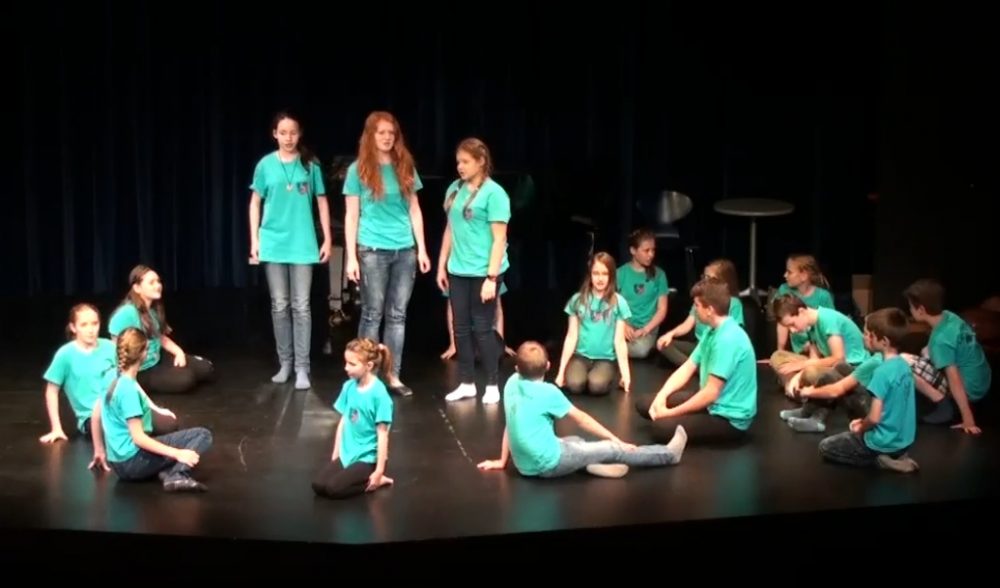Summary
The effectiveness of music play, helping the development of imagination, fantasy and creativity in children, might be intensified by the use of drama education elements. Intentionally, we apply here the principle of drama and experience incitement on the basis of own behaviour or experience. The children actively take part in the process in which they do not only use the so far gained knowledge and skills, but thanks to their imagination and fantasy, they create new plot situations, they indicate certain activities, their progress, they enter mutual interaction etc.
Element 2 independently follows the previous activities (Element 1). We motivate the pupils to the creation of music study expressing the morning waking-up of birds in the wood. The characterization and they way of manifestation of the portrayed characters plays a significant role, in this case different they are the representatives of the bird empire. In their stylization, we use the manifestation of folk literature. The creative elements are the part of the work with the texts in the form of rhythmization, melodization, dynamic, timbre and tempo interpretation, further instrumentation and movement expression.
References: Module 3,
Duration: 90 min
Key words creativity & entrepreneurship: Imagination, Interaction with the environment, Originality of ideas, Sensibility for problems diversity, Working in teams (music groups), Development of ideas and solutions, Finding of opportunities
Description
Step 1
The pupils are divided into six groups, they work with the prepared worksheets. Every group of children interprets the voice of the certain bird (yellowhammer, sparrow, cuckoo, lark, swallow, chaffinch) according to the given folk text and their idea. It is possible to work with a note record from the song collection with birds’ singing (see the worksheet for the pupils no. 1–6, M3B2PL1-6e).
The samples of the texts connected to the voices of birds:
- Yellowhammer (Emberiza citrinella)
- Ci ci ci ci ci ci cíííííííííííí! Ci ci ci ci ci ci cííííííííííííííííííííí!
- Kdyby si sedláčku chcíp! Kdyby si sedláčku chcíp! /kdɪbɪ sɪ sɛdlatʃ:kʊ xci:p kdɪbɪ sɪ sɛdlatʃ:kʊ xci:p/
- Vezu, vezu, vezu, vezu kvítí. /vɛzʊ vɛzʊ vɛzʊ vɛzʊ kvi:ti:/
- House Sparrow (Passer domesticus)
- Čim, čim, čim, čim, čim-ča-ra-ra, čim-čim-čim.
- Sedlák stréc, sedlák stréc! Sedlák pán, sedlák pán! Čert ho vem, čert ho vem! /sɛdla:k strɛ:c sɛdla:k strɛ:c sɛdla:k pa:n sɛdla:k pa:n tʃɛrt hɔ vɛm tʃɛrt hɔ vɛm /
- Common Cuckoo (Cuculus canorus)
- Ku ku! Ku ku! Sedím na buku! /kʊkʊ kʊkʊ sɛdi:m na bʊkʊ/
- Ku ku! Ku ku! V lese na buku! /kʊkʊ kʊkʊ v lɛsɛ na bʊkʊ/
- Woodlark (Lullula arborea)
- Pi – íííít, pry – ýýýýt, prrrrr-lyyy pít
- Já jsem se díval, jak sedlák voral. Vijo, vijo, vijo, vijo. Hot, hot, hot, hot, čihy, pryč! /ja: jsɛm sɛ di:val, jak sedla:k vɔral vɪjɔ vɪjɔ vɪjɔ vɪjɔ hɔt hɔt hɔt hɔt tʃɪhɪ prɪtʃ/
- Barn Swallow (Hirundo rustica)
- Vift, vift, ši-dly, vi-dly, vift, vift, ši-dly vi-dly.
- Šidly, vidly, šidly, vidly, dybych měla dobré vidly, kydala bych hnůj! /ʃɪdlɪ vɪdlɪ ʃɪdlɪ vɪdlɪ dɪbɪx mjela dobrɛ vɪdlɪ kɪdala bɪɣ hnu:j/
- Common Chaffinch (Fringilla coelebs)
- Rrrrr- čaf čaf čaf fraj – čáák
- Pink! Pink! Pink ra ra ra ra ra! Pink! Pink! Pink ra ra ra ra ra!
Step 2
According to the record in the worksheet, the pupils first rhythmically declaim the text, describing the corresponding bird. During the rhythmization of the text, they also work with dynamic, timbre and tempo part of the music expression.
Step 3
The pupils express waking-up of the birds in the form of playing Orff instruments (rhythmical or melodic percussions).
Step 4
Individual and collective reflection:
The pupils interpret their music arrangement of the task, they describe how they proceeded, what interested them. The others express their opinion on the way of realization.
Step 5
The pupils melodize the text using their own music imagination by playing instruments (Orff or classical). If the task is too demanding for some children, they might use or change the examples in note records presented in the worksheets which are taken from the collections of songs.
Step 6
The pupils accompany the structure set to music by a movement element.
Step 7
The pupils create a drama scene, they express morning waking-up of birds in the wood. They express their music imaginations vocally, by a rhythmical declamation and movement. They are active (individually or in groups) on the basis of planned plot of the story. Music realization might be unison of polyphonic.
Competencies
The pupils are able to:
- distinguish between the basic musically-expressive means
- be led to the development of the sense of orientation in a tone space
- listen to each other, inspire each other and perform in a music group
- express the content of the text using their voice, playing an instrument or by movement
- be led to development of polyphony, they respond to conductor’s gesture
- be motivated to sing from a note record
- create a plotline of the story and realize it in a musically-drama form on the basis of the given topic
Materials
- Bartoš, F. (21898). Naše děti. Jejich život v rodině, mezi sebou a v obci, jejich poesii, zábavy, hry i práce společné popisuje František Bartoš [Our Children. Their Life in a Family, between Each Other and in the Village, Their Poetry, Entertainment, Plays and Work Described by František Bartoš]. Praha: J. Otto, pp. 52–78.
- Erben, K. J. (21886). Prostonárodní české písně a říkadla [National Czech Songs and Rhymes]. Praha: A. Hynek, pp. 27–29.
- The worksheets for the pupils no. 1–6: M3B2PL1-6e
Module Overview
|
